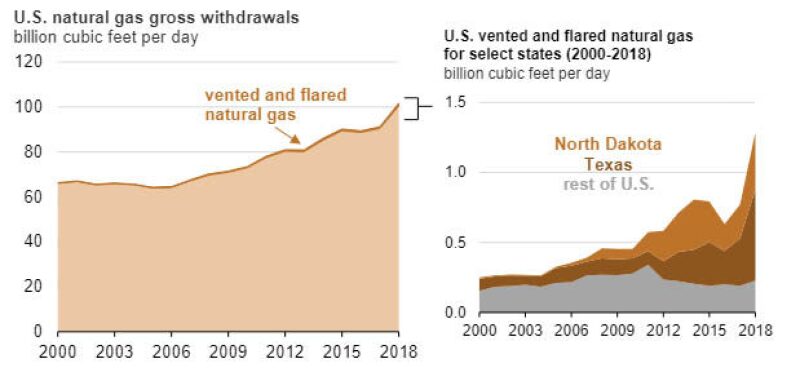The volume of US natural gas that was reported as vented and flared reached its highest average annual level of 1.28 Bfc/D in 2018, according to a new report from the US Energy Information Administration (EIA).
In 2018, the percentage of US natural gas that was vented and flared increased to 1.25% of gross withdrawals, up from 0.84% the previous year. The EIA said that two states, North Dakota and Texas, accounted for 1.1 Bcf/D, or 82% of the reported US vented and flared natural gas.
As crude oil production outpaces the buildout of infrastructure to handle natural gas, associated gas has been increasingly vented and flared in order to manage the undeliverable natural gas production from flowing oil wells. The EIA said that state agencies are largely responsible for regulating natural gas venting and flaring by imposing restrictions and natural gas capture requirements.
Texas and North Dakota accounted for 51% and 31%, respectively, of the total US vented and flared natural gas. The EIA said that both states are working with producers to limit the need for flaring without shutting down or affecting production of crude oil from new wells. Venting is banned in North Dakota and restricted in Texas.

Production grew five-fold between 2010 and 2018 in the Bakken shale play grew 500%, reaching approximately 1.5 million BOPD. During this time, natural gas producing plant capacity has not kept pace with the amount of associated gas being produced from oil wills. In 2018, North Dakota flared 0.40 Bcf/D, 17% of the total natural gas gross withdrawals in North Dakota and the highest percentage share of any state.
In 2014, the North Dakota Industrial Commission established Order No. 24665 to reduce the amount of flared natural gas, but the targets set under that order have not been consistently met. The EIA said expected completions of natural gas processing plant projects would increase the amount of natural gas operators could capture, as would additional capacity on interstate pipelines to move the processed natural gas to market and reduce the amount of natural gas flared.
The Permian Basin and Eagle Ford plays have contributed to a rapid increase in natural gas flaring in Texas in recent years. In 2018, vented and flared natural gas in Texas reached more than 0.65 Bcf/D, nearly double the 2017 level and around 2.5% of the total natural gas gross withdrawals in the state last year.
A number of new natural gas pipelines are planned or are under construction to transport greater volumes of natural gas to market, particularly from the Permian Basin.

